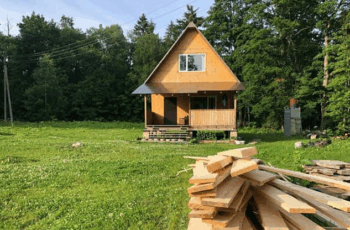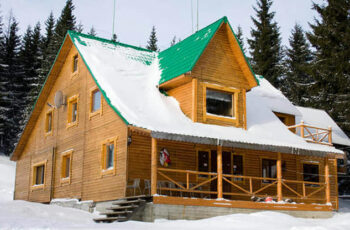
There’s something undeniably special about a log home — the smell of fresh wood, the way sunlight filters through timber walls, and that cozy feeling you get the moment you step inside. Building your own log cabin might sound like a dream that’s too big or complicated, but with the right approach, you can bring this vision to life without losing your mind or breaking the bank.
This guide will walk you through the essentials of creating your own traditional log home, from picking a spot in the wild to adding those finishing touches that make a house feel like a home. Along the way, you’ll learn what materials to choose, how to lay a solid foundation, and how to blend rustic charm with modern comfort.
Choosing the Perfect Spot for Your Cabin
Before hammering your first nail, you need to find a place that suits your lifestyle and the kind of retreat you want to create. Location is everything here — not just for the views, but also for practical reasons.
Start by thinking about access. Will you be able to reach your cabin easily in all seasons? Some beautiful spots might be charming but tricky to get to when the snow piles up or rains pour down.
Consider what the land itself is like. Is it flat or hilly? Are there trees providing shade, or is it open to the sun? What about water sources nearby? While proximity to lakes or streams is great, make sure the area isn’t prone to flooding or other natural hazards.
Don’t overlook local regulations. Every town and county has zoning laws and building codes that might restrict where or how you can build. Getting your paperwork in order early can save headaches later on.
Planning the Layout: Space That Works for You
Log cabins often have a reputation for being tiny and cramped, but that doesn’t have to be the case. Many traditional cabins range between 200 and 600 square feet, but how you use that space makes all the difference.
Think about how you live or plan to live in your cabin. Do you want an open plan living area that flows into a small kitchen and dining nook? Or do you prefer separate rooms for privacy and quiet? Maybe a sleeping loft appeals to you, giving you more floor space without expanding the footprint.
Designing a cabin that feels spacious starts with smart use of every inch. High ceilings, large windows to bring in natural light, and built-in storage solutions can make a compact cabin feel much larger.
Selecting the Right Wood: Foundation of Strength and Style
The choice of timber is more than an aesthetic decision; it’s about how your cabin will stand up to the elements and the years ahead. Cedar and pine are popular choices because they balance durability with relatively light weight.
Cedar is naturally resistant to decay and pests, which is a huge plus if you want to avoid harsh chemical treatments. Pine is more affordable and offers a warm, inviting look, though it might need extra care.
Make sure the logs are properly dried and treated. Wet or improperly cured wood can shrink or warp, leading to gaps or structural issues. Preservation treatments and sealants will protect your investment, keeping your cabin looking good and standing strong.

Setting a Solid Foundation
Your log cabin needs a strong base — a good foundation is what keeps everything steady and dry. Depending on your location and soil type, you might opt for a concrete slab, a pier foundation, or even stone footings.
Concrete slabs are great if you want a solid, level floor and plan to use the cabin year-round. Pier foundations lift the structure off the ground, allowing air circulation underneath which helps prevent moisture buildup and wood rot.
Whichever foundation you choose, make sure the ground beneath is well-prepared. Clear debris, level the site, and consider drainage solutions to keep water away from your cabin’s base.
Building the Walls: The Art of Log Stacking
Now comes the hands-on part. Building your log walls requires patience and precision. You’ll start by laying the bottom course of logs, making sure each one is level and aligned perfectly.
The corners of your cabin will likely use traditional notching techniques — these are interlocking cuts that help logs fit snugly together, keeping out drafts and making the walls strong.
Between each log, you’ll need to apply insulation, commonly called “chinking.” Traditionally, natural materials like moss or clay were used, but modern synthetic chinking offers better durability and flexibility.
Take your time with windows and doors. They’re more than just openings — they let light in and connect your cabin to the outdoors. Frame them carefully, seal tightly, and choose materials that match your cabin’s rustic feel without sacrificing energy efficiency.
Roof and Weather Protection
The roof is your cabin’s shield against the weather. Choosing the right roofing material is crucial. Wooden shingles fit the rustic aesthetic perfectly but require maintenance. Metal roofs, on the other hand, are long-lasting, lightweight, and can handle snow or heavy rain without issue.
Ventilation is key to prevent moisture buildup in your attic or roof space. Moisture can lead to mold or rot, which damages the structure.
Don’t forget gutters and downspouts. They channel rainwater away from your cabin, protecting your foundation and keeping the exterior logs dry.
Interior Touches: Making Your Cabin Feel Like Home
Inside your log cabin, you have plenty of options to create a cozy and functional space. For flooring, wood planks offer warmth and continuity with the log walls. If you want something easier to maintain, consider tile or vinyl in kitchens and bathrooms.
Plumbing and electrical work should follow local codes, and if you’re not experienced, hiring professionals can save you trouble down the line.
Rustic furniture, stone accents, and warm textiles bring character and comfort. You don’t have to stick strictly to old-fashioned styles—mix in modern pieces to keep the space fresh and personalized.

Maintaining Your Log Cabin
Building your cabin is just the beginning. Regular upkeep keeps it safe, comfortable, and beautiful.
Inspect logs for cracks or gaps regularly, especially after harsh weather. Reapply sealants every few years to maintain protection.
Keep gutters clean and check your roof for damage.
Inside, control humidity to prevent wood from drying out or growing mold. Using natural cleaning products avoids harsh chemicals that can damage wood and the environment.
Why the Effort is Worth It
Creating your own log cabin isn’t just a construction project—it’s an opportunity to craft a space that reflects your values and lifestyle. You’ll gain skills, enjoy the satisfaction of hands-on work, and end up with a home that’s truly yours.
The timeless charm of logs, combined with modern comforts, makes this a dream worth pursuing.


